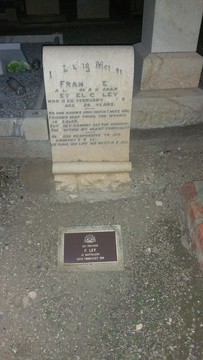
LEY, Frank
| Service Number: | 2111 |
|---|---|
| Enlisted: | 8 July 1916 |
| Last Rank: | Private |
| Last Unit: | 37th Infantry Battalion |
| Born: | Wentworth, New South Wales, Australia, July 1890 |
| Home Town: | Lucindale, Naracoorte and Lucindale, South Australia |
| Schooling: | Not yet discovered |
| Occupation: | Station hand |
| Died: | Carcinoma of caecum and right kidney, Military Hospital in Caulfield, Victoria, Australia, 28 February 1919 |
| Cemetery: |
West Terrace Cemetery (AIF Section) Located at plan 3, row 3, grave #108., |
| Memorials: | Adelaide National War Memorial, Australian War Memorial Roll of Honour, Lucindale War Memorial |
World War 1 Service
| 8 Jul 1916: | Enlisted AIF WW1, Private, 2111, 43rd Infantry Battalion | |
|---|---|---|
| 28 Aug 1916: | Involvement AIF WW1, Private, 2111, 43rd Infantry Battalion, --- :embarkation_roll: roll_number: '18' embarkation_place: Adelaide embarkation_ship: HMAT Anchises embarkation_ship_number: A68 public_note: '' | |
| 28 Aug 1916: | Embarked AIF WW1, Private, 2111, 43rd Infantry Battalion, HMAT Anchises, Adelaide | |
| 28 Feb 1919: | Involvement AIF WW1, Private, 2111, 37th Infantry Battalion, --- :awm_ww1_roll_of_honour_import: awm_service_number: 2111 awm_unit: 37th Australian Infantry Battalion awm_rank: Private awm_died_date: 1919-02-28 |
Help us honour Frank Ley's service by contributing information, stories, and images so that they can be preserved for future generations.
Add my storyBiography contributed by St Aloysius College
Frank Ley was born in 1890 (c. July) in Wentworth, New South Wales, the oldest child of Mr. Thomas Ley and Mrs. Ley. He was raised a Methodist.
At around the age of ten, he (and his family) moved to South Australia, where he later became a station hand.
At the time of his enlistment he was 5 feet 10 ¼ inches (1.78m) – tall for the time – and weighed 184 pounds (83.46kg). He had dark complexion, medium blue eyes and dark hair, as well as perfect vision in both eyes.
In 1916 he married Ethel Catherine (alternatively spelt “Katherine”) Ley in Robe, and on the 8th of July the same year he enlisted in Adelaide, South Australia, becoming a Private with service number 2111. He was assigned to the 3/43rd Battalion, and on the 28th of August he embarked from Adelaide, South Australia, aboard the HMAT Anchises. He arrived in Plymouth, England, on the 11th of October.
Exactly one month later on the 11th of November he was transferred to the 37th Battalion, and on the 22nd he travelled from Southampton, England, to Havre, France - then to Bailleul, Strazelle then Armentieres; all in France.
While on active service he was admitted to hospital for general illness multiple times - on the 8th of July he stayed there for 11 days before his discharge on the 19th of July. He was readmitted shortly after (30th of July until the 8th of August) then a third time on the 11th of October 1918 – the following day being transferred to a local hospital.
He fought for over a year before going to England for leave on the 19th of January 1918, returning less than a month later on the 2nd of February.
On the 20th of October he was transferred to Le Havre, France.
Note: The following dates of his biography have been documented multiple times, many with conflicting or unclear dates. The dates produced here are the most repeated/likely of those available.
One day after the Treaty of Versailles was signed (causing Germany to formally surrender and ultimately ending the First World War), Frank Ley was admitted to a general hospital in Le Havre, France - life-threateningly ill. On the 21st of November, 9 days later, he was declared invalid and unfit for war. Four days later he was admitted to the Brook War Hospital in Woolwich, England, because he had a carcinoma (form of cancer in the lining of the internal organs) in his right kidney and caecum (the pouch connected to the junction of the small and large intestines). He was unsuccessfully operated on, with a large tumour still present.
On the 6th of December he was transferred to the 3rd Australian Auxiliary Hospital in Dartford, England, and on the 20th of January 1919 he was discharged from the hospital in order to be sent back to Australia. 9 days after his discharge he began his return voyage to Melbourne, Australia. After travelling on board the hospital ship “Karoola,” he arrived in Australia and was transferred to the No. 7 A. G. Hospital in Keswick on the 13th of February.
There is no record of Frank Ley being transferred from Keswick to Victoria, however it has been documented multiple times that on the 28th of February 1919, at 8:40pm, he died at the Military Hospital in Caulfield, Victoria, aged just 28.
Ley was posthumously awarded the British War medal, a medal for anyone who was involved in a battle or overseas service. It was originally sent to the District Base Headquarters, Adelaide, but after remaining unclaimed it was sent to his widow, Ethel Catherine Ley, in 1933.
He is now buried at the Adelaide West Terrace Cemetery, located at plan 3, row 3, grave #108.










